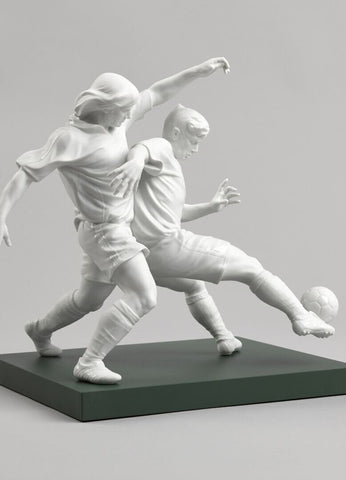Greek Art: Why Was Nudity So Central in Greek Sculptures?
Tagged with:Culture & Civilisation
Share
Why Naked Greek Bodies belongs in Museums
The ancient Greeks created and popularised the modern notion of the human self. The Greeks explored the idea and philosophy of the individuality of each person - that each has a unique soul but at the same time, has attachment and responsibility as social beings to society.
The Greek persona Icarus (left). Read his story here.
Lladró makes an extensive range of Greek sculptures, from the Greek gods such as Icarus, Eros(Cupid) and Psyche, to the motherhood or contemporary dancer pieces.
WHY WAS NUDITY SO CENTRAL TO GREEK ART?
An Athenian vase dated back to 530 BC depicts four athletes at the Olympic Games, all naked whilst competing in their events. Nudity in Greek art is such a norm that one might mistakenly conclude that people were typically in a state of undress at that time. But public nudity wasn’t the standard, unless confined within a walls of gender specific gymnasium and baths. It was definitely not the norm for nudity to be accepted when both sexes are present. So why are Greek sculptures and statues mostly nude?
Atlas, the greek titan.
Why the athletes competed buck naked is still a mystery, but what is for certain is that it was the first instance of nudity being perceived as representing strength, or being heroic. This is a vital change and reason why Greek art is still so popular. Other civilisations have depicted nudity in their art before the Greeks did, but it was always as a sign of weakness, shame or being humiliated. The Greeks, however, are comfortable with nudity and see it as a sign of moral virtue, timeless beauty, and heroism.
With this in mind, sculptors began to create more lifelike sculptures, idealising the human body, and kept perfecting the form. Sculptors expressed positive values such as strength, love, victory and compassion artistically by varying the poses and expressions. By sculpting nude statues, that represents that the values are intrinsic and true, that underneath it all there is nothing to hide, that what you see is exactly what it is. What used to adorn the human body, such as clothing, jewellery, tattoos and other embellishments, is done sparingly, as sculpting humans or gods in nudity is seen as displaying the honest value of the character.
Even in recorded representations of war, one can easily distinguish Greek warriors from their enemies in the same image, just by noting which warriors are nude.
THE STUDY OF ANATOMY
Artists always observed the human body closely, to understand how it looked and moved, even appointing models to study each detail multiple times and with different body shapes. At that time, there was no division between art and science, instead it was seen as a fluid subject, and most philosophers, physicists and artists seamlessly floated between disciplines whilst they explore different ideas.
A man’s back muscles with anatomical precision. Note the natural fall of the man’s left foot and toes. Pictured: Lladró’s Everlasting Love sculpture
But to create anatomically accurate sculptures, is a whole other discipline. Every muscle, nerve, joint has to be sculpted with precision, and if even one part or section of the piece is out of proportion, it does not have the same effect. The difference of getting from 95% accurate to 100% accurate makes a world of a difference to the viewer’s eye.

Deep in thought.
Artists and scientists dissected dead bodies to understand the composition and how the body works, even though the Catholic Church prohibited dissection. Both artists and scientists thought it was crucial to be more accurate and sure, on how the human body works. To find out what muscles are used when one clenches their hand, which nerves protrude out, that the index finger sits 0.5cm higher than the middle finger and which muscles in the upper arm naturally flexes, all this minute details require endless studies and dissections before it can be near perfection. This resulted in “naturalism“ in Early Renaissance, for the human form to be more like real life, in far more comfortable and everyday positions.
The efforts and scientific research required to sculpt and create anatomically accurate statues and sculptures gave artists an elevated acknowledgement and status from before, to be on par as intellectuals and philosophers, as their work is also based on research and accurate representations of humankind.
THE GREEK GODS
The Greeks always put mankind at the centre, even in the image of their gods. Yes, they were the very perfect examples of humans, more grander and beautiful, but there is always a humanity within their personalities, although the gods did not die.
The soccer players are finished in gloss glaze at specific spots to catch the light (left). A younger depiction of Icarus, delicately balanced on two wings (middle). A couple with their newborn baby.
Take this series of nude goddess by Lalique for example. Flora, the Goddess of nature captivates in crystal with her voluptuousness and grace, she watches over foliage, allowing nature to awake each year. The cherry blossoms on her back evoke the world-famous and wondrous blossoming of Japanese cherry trees.


Lalique's Flora Nude Sculpture Limited Edition
Lalique's Flora Nude Sculpture Limited Edition
Fascinating, voluptuous and graceful, this crystal Aphrodite is an interpretation of the goddess of love, symbol of beauty and fertility. Her splendour, her disrupting sensuality, her pose, and her elusiveness, illustrate how the Lalique glass masters metamorphose crystal into unique creations, filled with grace and sensuality.
Aphrodite decanter enriches the existing Lalique collection. Limited-edition 2017 Aphrodite decanter in clear crystal, crafted to enhance fine spirits with elegant, sensual curves and satin-finished brilliance.










